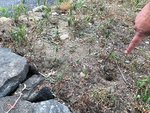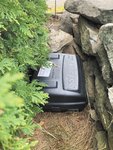It’s 9:30 on a Thursday morning and Rodent Control Coordinator David Laquale is busy baiting rat traps at Cranston residences. He’s scoping different yards for the rodents’ burrows …
This item is available in full to subscribers.
We have recently launched a new and improved website. To continue reading, you will need to either log into your subscriber account, or purchase a new subscription.
If you are a current print subscriber, you can set up a free website account by clicking here.
Otherwise, click here to view your options for subscribing.
Please log in to continue |
|


It’s 9:30 on a Thursday morning and Rodent Control Coordinator David Laquale is busy baiting rat traps at Cranston residences. He’s scoping different yards for the rodents’ burrows and “runs” which are the routes that the rats travel to find food and water. Currently there are 3,000 bait boxes being used throughout the city, and Laquale is traveling to five new baiting appointments per day along with 10 appointments for re-baiting.
Yet, despite such efforts Director of Public Works Richard Bernardo says the way to reduce the rat population is to change human behavior.
“Unfortunately, this is not a staffing issue and this is not a budget issue,” said Bernardo at July’s public works meeting. “The rats are breeding at a faster rate than we can possibly kill them.”
Cranston’s rat problem is not a new one. Bernardo said this is an active year across the state for the rodents, especially in areas such as Warwick, West Warwick and Providence. Cranston has a backlog of 115 indemnification forms, which residents fill out to allow the city to come onto their property and bait the rats. Bernardo said if a resident put in a request today for the city to come and address a rat problem on their property, it’s likely that Laquale would not be able to get to the property until September. In some cases, Cranston residents have hired a rodent control company to visit their home to avoid the wait for service.
Bernardo said the public’s attitude needs to change toward composting, roosters, animal waste and wood piles which provide nesting sources. For starters, residents should avoid filling bird feeders and using bird baths. Bernardo said birds have natural food sources in the summer and feeders are only necessary in the winter when the food supply is limited.
Additionally, compost should be kept in a contained barrel with a lid. If left in the open, Bernardo said residents are setting a dinner table for rodents. Animal waste is also a food source for rats and should be picked up from around the yard, bagged and thrown in the trash. Bernardo referenced chickens as another attractor of rats since the rodents are drawn to their droppings and feed.
Wood piles may be nice to have for heating purposes in the winter, however, they create a great nesting area and protected oasis for rats among the natural debris. Bernardo added that fruit trees are also a large draw to rats, saying this is like filet mignon for rodents.
According to Laquale, rats travel up to 300 feet per night (roughly the length of a football field) to search for food and tend to travel along walls or fences where they feel safe. He added that a female’s burrow could include her and six to eight pups.
A resident may have a pristine property but, because of the distance rats travel, the rodents may find their way onto neighboring properties; the key is to find the source of where the rat is coming from and address it there.
The city’s rat problem is in both Eastern and Western Cranston, with a higher concentration in the eastern half since it is more urbanized. The city recently tested a new bait, First Strike, in Cranston’s Midwood neighborhood which is more potent and kills the rodent quicker. Bernardo said so far the new poison has worked well. The bait is 50 percent more expensive than the other material the city was using – which was $90 per bucket. Overall, the city has budgeted $25,000 for rodent control and Bernardo said to date, they have spent roughly 10 percent of those funds.
After Laquale sets the bait, the rats will smell it out and eat it but will not instantly die. Bernardo said once the rodents realize they are dying, they will attempt to get back to their burrow and pass away there. Sometimes they don’t make it and die in a resident’s yard. Therefore, it is important that pet owners don’t let their pets into the yard unsupervised because if they pick up a dead rat, they will be eating poison. Bernardo said the new bait is no more dangerous to pets than the previous bait, but homeowners should be picking up rodents after they die and bagging them before throwing them in the trash.
While the rat population picks up in the spring and slows down after the first frost, they will continue to survive if they have access to an accessible food and water source. If human habits don’t change, then rats will still have the opportunities to breed.
“Every residence needs to play their part,” Bernardo said.
4 comments on this item Please log in to comment by clicking here
sb_boston
Uh… where’s the part about food litter? Yes, rats will eat the feces of other animals, but they much prefer fast food and snack wrappers. A little bit of ketchup or pizza crust is way better than a mouthful of
Saturday, August 6, 2022 Report this
sb_boston
… a mouthful of
Saturday, August 6, 2022 Report this
sb_boston
It would appear that my comment is too long for this platform, so here it is in a Google doc. Anyone should be able to read it
Saturday, August 6, 2022 Report this
sb_boston
…and you can’t edit or delete your comments once you hit the button.
https://docs.google.com/do***ent/d/13SfjjPD_zDMWbG3DllSQ9XPmNqB99cfm0zWWhED-Iqk/edit
Saturday, August 6, 2022 Report this